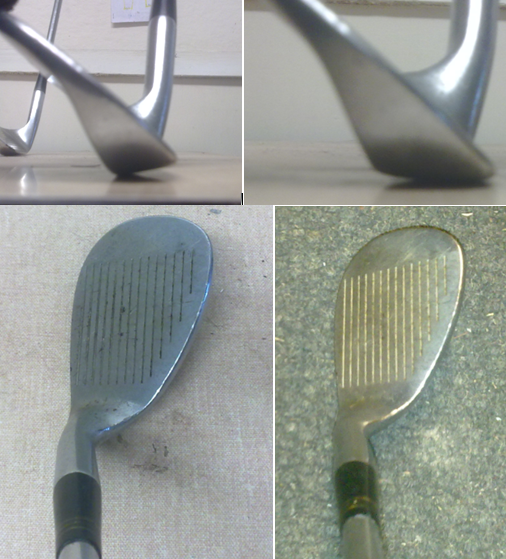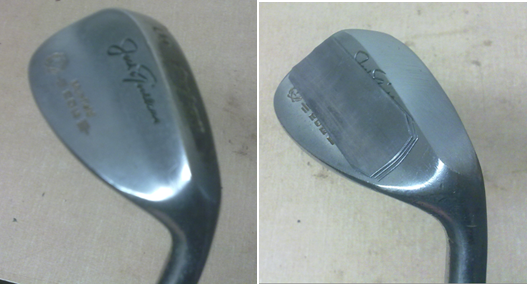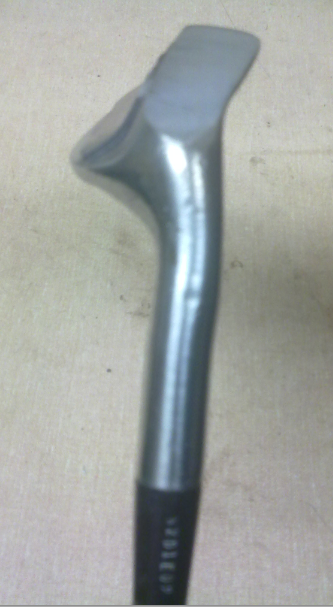For one, I like the hard to find “Split Sole” PW’s. I can open the face up and hit a cut shot off hardpan without fear of belly blading it. I like the sharper leading edge… rather than the typical blunt front ends on most wedges… for play from the rough, and of course I remove all offset… if anything prefer just a bit of leading edge face progression so that I can spin the ball or work it in right to left much easier if needed.
I progressively dead weight and swing weight my wedges heavier realizing accuracy is my #1 concern, and I want as much feel in my hands as possible, and I also want to be hitting the ball with as much mass as I can handle in the head if not for the sheer impact physics of optimal compression at slower velocities. With the heavy head, I can grip the club firmer without sacrificing feel, and this also aids in stabilizing the clubhead due to any off centered hits I might subject myself to as I don’t usually play more than a three rounds a month nor do I hit balls in between.
My “gap wedge” really isn’t a gap wedge, rather it is a PW with sand wedge loft for shots inside 80 yards. Little or no bounce, heavy, flat and stiff. Mine is an old Spalding Tournament model from the early 50’s. Great head, sets up properly and has a firm leather grip on it.
The Spalding has a very flat bottom grind on it which I like for fairway play, while my actual SW has more of a contour sole which aids in dealing with more extreme side hill or slanted shots typically found on various bunker faces or slopes.
My SW is also at 56… but has a medium width flange and about 8 degrees of bounce. I don’t like too wide a flange, so would lean toward narrower flange but with more bounce than normal. This of course is primarily for sand shots or thick nasty greenside rough where mass reigns king. I don’t want anything slowing the club down through impact and this is where I really pour on the acceleration. So combining
acceleration, a heavy mass, and some bounce with a flange that is not too wide leads me right to vintage Wilson wedges. R 20 or R 90 are ideal. They also made unmarked heads or heads with top tour players circa that era that were forged nearly identical.
I will remind everyone here again… a Wilson wedge that actually says “ORIGINAL” R 20 or R 90 IS NOT ORIGINAL. These are the 1970’s remakes that are actually cast heads, lightweight, have no bounce and are better to use as tomato stakes for your summer garden.
So we have been retro fitting some ABS SW’s on LagBay that I have been hand picking out… bending to spec and weighting them up to 18 ounces when needed.
I also bend them upright, so that when I open up the face (which will lower your hands considerably) my hands simply drop right down to where I play all my other shots from with the same lie angle as my other wedges.
You don’t want the club spending a lot of time in the sand. Steep in and out with good bounce will allow you to stay aggressive, hit down into the sand with some confidence and loft the ball up with a proper high trajectory. If sand is really hard or wet I will use my PW.
I see the wedge game as a balance between trajectory and distance control. I don’t need a traditional gap wedge because distance control with wedges is not much different than lag putting… it’s all feel and learning how to find and establish your proper parameters for gauging distance… which is an acquired skill.
My wedge play has improved 300% by moving into very flat heavy wedges. I don’t pull them left anymore, and the added weight gives me superior distance control because to get the ball 30 feet past the hole is going to take a lot more effort than with a light wedge. I can feel
the head now, and can anticipate what too hard and too soft actually are before I execute the shot.















